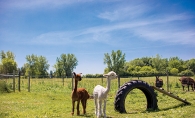With a wingspan of just less than 4 inches and weighing in at one-fifth of an ounce, the North American monarch butterfly’s 3,000-mile migration from Mexico to Minnesota is one of nature’s biggest marvels. These winged wonders have never seen the mountains and waterways that mark their journey northward in the spring and southward in the winter, yet they know exactly, instinctively, the path they must follow. It takes four generations of monarchs to complete the journey, as the summer monarch’s lifespan is from 2 to 6 weeks, but come early May and on into June and July, the landscape comes to life in more ways than one.
Cindy Schmid is passionate about monarchs and knows this inspired cycle better than most. As head of the Mahtomedi Garden Club, Schmid started her very own monarch way station to provide places for monarchs to lay their eggs and sustain their migration. Schmid’s monarch passion aligns perfectly with her other passion: the preservation of native plants in Minnesota. So how do these two passions marry? Simply put: milkweed. In fact, her springtime email signature includes “Got Milkweed?”.
Milkweed doesn’t sound like a very exciting plant; the name makes it sound more like something you’d want to eradicate than the beautiful plant that is the exclusive food for and birthing place of monarch butterflies. It’s also diminishing in our neck of the woods. And since it’s the only plant that monarchs lay their eggs on, you can see why Schmid works so hard to preserve and grow it.
Common milkweed takes up the majority of Schmid’s one-acre garden: it’s the leafy plant that creates a lot of the fluffy fuzz found in ditches. Swamp milkweed, on the other hand, produces lovely pink flowers, and butterfly milkweed adds bright pops of orange.
Schmid also incorporates other plants into her garden, such as lantana, Mexican sunflowers, ironweed, goldenrod and blazing star, which add even more vibrant colors. But milkweed has stolen her heart. “It enhances your yard any time you can plant for hummingbirds or butterflies; it just adds to your garden and it’s a very easy thing to do,” Schmid says.
Schmid registered her way station back in 2005 through Monarch Watch, an education, conservation and research program at the University of Kansas, whose mission is to stop the decline in the monarch population. “Monarch Watch has everything to do with monarchs: education, tagging, conservation and education,” she says.
Schmid also works at Journey North tracking the migration patterns of monarchs. So far she has been able to track 11 migrations. “It’s really interesting to see trends in such a short time,” Schmid says.
Unfortunately, over the years there has been a decline in the monarch population. Schmid says this is due to the decline in milkweed as habitat makes way for new construction and pesticides are sprayed on farmlands and in ditches. “It’s just more of an awareness that our environment is changing,” Schmid says. “The decline of the monarchs is kind of like the canary in the mines because they are very sensitive to environmental changes.”
Helping the monarchs is something that is second nature to Schmid, who grew up in a family of gardeners. “Gardening is kind of an appreciation of art and nature together. I love art and I really like nature, so that’s where gardening fills in,” she says. “It’s knowing that you’re doing something good for the planet, that you’re trying to add to the environment and help the environment rather than take away from it.”
Want to try your hand?
Tips for growing milkweed
Starting a way station is as easy as adding a few milkweed plants to a current garden, says Cindy Schmid. Common milkweed and swamp milkweed are readily available at stores, and Monarch Watch sells way station seed kits online.
Tips for raising monarchs
“It’s really fun to raise monarchs from the wild,” says Cindy Schmid. “Many eggs never make it to larvae, because people don’t realize there are live monarch eggs on milkweed when they pull it out, spray it with herbicide or mow it over. Leave the milkweed, or if that’s not an option, pull it out and check it for eggs; if you have eggs on the milkweed, raise them!”









